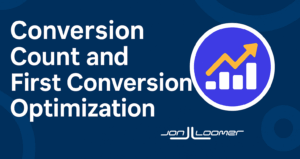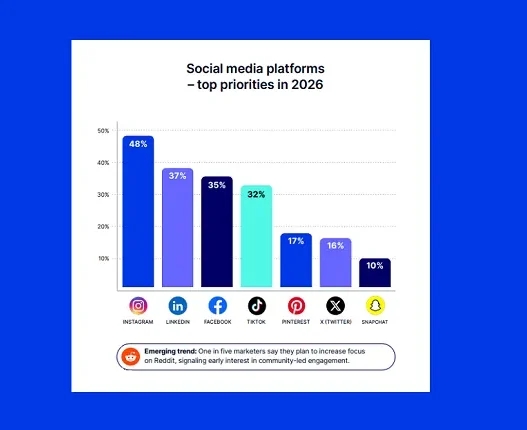
Some advertisers are seeing the option to select First Conversion under a new “Conversion Count” setting in the ad set. It’s not clear whether this is a test or the beginning of a new rollout.
First Conversion reporting, which limits reporting to only the first measurable action a person takes after seeing or clicking your ad, isn’t new. It launched in July of 2024. But allowing Meta to optimize for it would be.
Since there’s no official documentation on this, I have a lot of questions. Why would you use this? What problem does it solve?
In this post, I am going to do my best to connect the dots…
What I’m Seeing
To figure out if you have this, follow these steps…
1. Create a campaign using the Sales objective. As far as I can tell, it’s not available for any other objective.
2. Select the Website conversion location in the ad set.

3. Select the performance goal to Maximize number of conversions.

If you select any other performance goal with the Website conversion location, Conversion Count automatically defaults to “All Conversions” and can’t be edited.

If you make all of these selections, click “Show more settings” under the attribution model.

If you have this, you’ll see “Conversion Count” under the attribution settings.

It’s set to All Conversions by default. If you click to edit, you can select First Conversion.
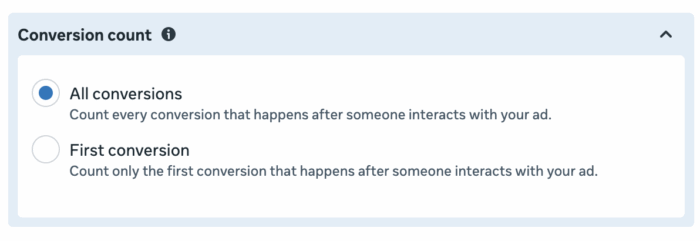
What is First Conversion?
Okay, so let’s back up a moment. New option in the ad set, great. But what does it actually mean?
As I said at the top, First Conversion isn’t new as a reporting option. Meta launched it more than a year ago, but it’s only been as a reporting option. When you click to compare attribution settings, you can choose from All Conversions or First Conversion (or both).
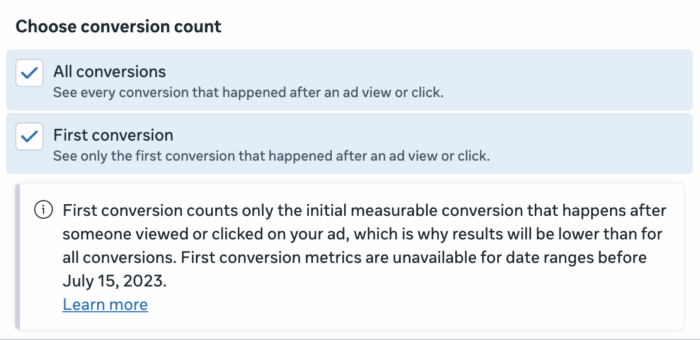
Per Meta:
First conversion counts only the initial measurable conversion that happens after someone viewed or clicked on your ad, which is why results will be lower than for all conversions.
Let’s consider a scenario when this would apply…
1. You are running a Sales campaign that uses the “Maximize number of conversions” performance goal where Purchase is the goal conversion event.
2. Someone clicks on your ad and makes an immediate purchase.
3. Two days later, this person returns to your website. They make a second purchase.
Assuming you are using the default attribution setting (or at least 7-day click), Meta will report both conversions that resulted from your ad when using All Conversions. First Conversion would only report the first.
Selecting First Conversion for reporting is a good way to better understand unique customers. It’s helped me solve problems matching up reporting.
When First Conversion is selected while comparing attribution settings, you’ll get a separate column that will limit reporting to only the first conversion someone made. I use this often when digging into my registration reporting since people will often complete forms for multiple lead magnets on my website.

In the example above, Meta reported 46 total conversions, but only 35 first conversions. So we can more accurately say that 35 people registered 46 times.
Keep in mind that this also applies to reported conversion value and ROAS. When using First Conversion, Meta will only report on the value driven by that first conversion that someone made.
What Does This Change Mean?
Now, let’s get back to the change. Some advertisers can now select First Conversion within the ad set when maximizing the number of conversions with Sales campaigns.

Here’s the most relevant portion from the tooltip in the above screenshot:
Conversion count determines which conversions are counted after someone clicks or views your ad and takes an action. Our system will learn from the conversions counted and show ads to people most likely to convert.
Based on this, we can assume that two things happen when you select First Conversion as the default way of counting conversions:
1. Meta will only report the first conversion that someone makes after clicking or seeing your ad.
2. Meta’s systems will learn from only those first conversions when showing your ads to others.
The first is interesting, but the reason for this change wouldn’t be to simply change default reporting to First Conversion. That’s helpful, I guess, but it’s information that was always available.
The biggest change here is that by selecting First Conversion in the ad set, you are altering the data that Meta is learning from to deliver your ads.
The Impact of First Conversion
I can only speculate how this will impact delivery and results. Without official documentation or history to pull from, speculation is all we have.
But the most likely scenario is that you’ll see fewer conversions reported by default. You’ll still be able to select “All Conversions” when comparing attribution settings to get the total number. But you’ll no longer need to dig to view the number of first conversions.
Of course, that’s my logical guess. But Meta learns from these conversions, so delivery would be different than if you had used All Conversions. And maybe… that could result in more unique customers? I’m stretching on this because I really don’t know.
Still, the most logical impact is that you’ll see fewer conversions reported by default. It may not mean fewer conversions overall, though.
Similar Attribution Use Cases
Let’s look at some similar attribution-related decisions. In all cases, there’s a clear reason for moving away from the default. It not only impacts reporting, but it solves a problem with how your ads are delivered.
1. Value vs. Number.
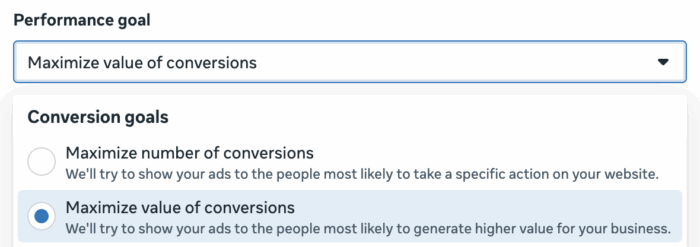
By default, Meta will optimize ad delivery to focus on generating the most conversions. But if you choose to “maximize value,” the focus turns to generating a higher Return On Ad Spend.
The specific problem this solves relates to a situation where you might sell many products with a wide range of price tags. If you stick with the default, Meta will be focused on getting you as many purchases as possible. That could be a high volume of $10 purchases. But if you switch to Value, Meta may instead focus on getting purchases of your $100 product.
There would be a likely tradeoff of volume for value. But it’s a trade that makes sense in specific situations.
2. Incremental vs. Standard.

By default, Meta uses the Standard attribution model. But beginning earlier this year, Meta rolled out the ability for advertisers to select Incremental.
When selected, Meta’s systems would prioritize conversions that were caused by your ad. In theory, some of your conversions may have happened without your ads, typically due to remarketing situations. So Incremental would help maximize the quality of your conversions, and potentially help attract new people.
Or at least that’s been the hope. I haven’t seen any strong use cases of incremental attribution at this point, and my reporting seems to align Standard very closely to Incremental results.
The idea, though, is that there could be a tradeoff of volume for quality and lifetime value.
3. Click vs. Click and View
The default attribution setting is 7-day click and 1-day view. This means that Meta will report on conversions that happened within 7 days of clicking or 1 day of viewing (without clicking) your ad. Meta will also optimize delivery to maximize results based on those settings.
Understand that Meta will always do whatever it can to drive up your conversion reporting, staying within the settings you’ve defined. And view-through conversions are a great way to take advantage of a potential weakness, especially from remarketing.
The most valuable conversion is 1-day click. It’s the one we can say with most certainty that your ad drove that result. And 7-day click has value for higher price points that require longer consideration. While 1-day view has value with context, it can also be abused.
If Meta can pad your numbers with view-through conversions, it will. This is less a problem with running ads for a purchase, though you may see it there as well. By removing 1-day view in the ad set, Meta knows that your numbers can’t be padded that way. So delivery is adjusted to focus on click conversions.
What Problem Does This Solve?
I was excited when I first stumbled on this because I’ve long wondered why First Conversion was limited to a reporting option. But now that it’s available for ad set optimization, I’m struggling to understand why it would be useful.
In all of the use cases listed above, there is a specific problem that the attribution adjustment solves. In each case, it could be at the expense of volume, but with the tradeoff of value or quality.
We know that by making this change, default reporting will be First Conversion. That’s fine, but it was always available anyway. The main reason you made the adjustments above was that it solved a problem about delivery.
Let’s think this through…
1. By changing to First Conversion in the ad set, Meta’s systems will only include the first conversions for learning data.
2. When someone performs multiple conversions, they will not be seen as more valuable than someone who performs one.
So if someone made three separate purchases, that would be reported by default using All Conversions. But if you switch to First Conversion in the ad set, it will only count one purchase. And Meta won’t see that person as any more valuable for having made three purchases.
What is the problem that is solved here? Where is the tradeoff? There will be a likely drop in volume in exchange for… what exactly?
There are a couple of examples that could make sense, but they don’t involve purchases. Maybe that could be useful for leads because there’s no reason to value a lead more if they complete a lead form twice. And there’s no reason to count it twice.
Another is when using custom events to measure website engagement. For the past several years, I’ve had custom events for things like time spent, scroll depth, website video views, podcast plays, and more. I’ve used this for both reporting and optimization purposes. I could promote a blog post and optimize for a 1-minute visit, for example, instead of a link click or landing page view.
But once First Conversion reporting became an option, I realized how flawed this approach was. Since a single person could perform several 1-minute visits, my results could be grossly inflated by a few people. Here’s one such example…

The example above is extreme to make a point. Yes, it is utilizing 7-day click and 1-day view. And the difference would be less for 1-day click. But the problem would still exist.
So, sure! First Conversion optimization could conceivably be an option to solve this problem. But Meta clearly isn’t thinking of this scenario when making such an option available.
Why? Because this option is only available for the Sales objective. If Meta thought this would help solve a problem with leads, it would be available with the Leads objective and Website conversion location. If Meta wanted to help us solve a problem with custom events related to website engagement, it would be available for the Engagement objective and Website conversion location.
But it’s not. Only Sales.
This is exactly the scenario where you’d want Meta to value people who make multiple purchases. And I’d want to see all purchases that resulted from my ads to be reflected in performance.
The only argument I keep coming back to is so that results are more “accurate” by default. They’re more likely to match up with third-party reporting.
But this also impacts how your ads are delivered. And I can’t confidently say I understand why the tradeoff of volume for (??) would be worthwhile.
A Remarketing Angle?
The only explanation I can come up with that feels the least bit feasible is related to remarketing. But let me warn you now that I don’t completely buy these arguments.
1. It could limit a focus on remarketing and push toward prospecting.
The assumption is that current customers are more likely to make multiple purchases than new customers. But new customers are more valuable to acquire because they become current customers who will buy more stuff. So optimizing for First Conversion will limit the amount spent on remarketing.
And that’s all fine as an argument (and it’s legitimate in many cases), but the question is whether this is a solution. Doesn’t First Conversion also devalue new customers who make multiple purchases in your conversion window?
2. It could eliminate a possible repeat click scenario.
Look, I’m reaching here. But under the All Conversions default, Meta might focus on someone more once they’ve completed a purchase (assuming they aren’t excluded). Especially if you’re using the 7-day click and 1-day view attribution setting, more conversions could be added to your reporting if the ad keeps showing for a limited amount of time.
I get it, but… This also assumes that First Conversion eliminates the second conversion. I know, this is getting super technical, but let me explain.
My understanding of First Conversion reporting is that if someone clicks or views your ad, only the first conversion resulting from THAT engagement will be counted. So, someone can click your ad and convert immediately, then come back three days later. Both would be counted under All Conversions. But only 1 within First Conversion.
But if someone clicks your ad on Monday and converts and then clicks your ad on Wednesday and converts, that would be two separate click events. My interpretation is that First Conversion would NOT solve for that.
And this is assuming you think that’s a problem to be solved in the first place. And that’s what I keep coming back to.
Purchase Volume and Learning Data
Another potential problem is that optimizing for First Conversion could (should?) limit the number of optimized events. And that’s rarely a good thing when optimizing for purchases.
If you want to exit the learning phase, you need approximately 50 optimized events per week per ad set. Even I’ve speculated that the inability to exit the learning phase may be overblown as a problem, but Meta clearly makes reaching this threshold a priority.
So if you were already struggling to exit the learning phase with All Conversions, switching to First Conversion will cut back on Meta’s learning data even more. And that can’t be a particularly good thing.
So even if First Conversion optimization solves a problem, it would seem this should only be an option to consider for those spending enough to exit the learning phase already. Not that exiting the learning phase is critical, but it suggests you’re getting adequate volume already.
Future Clarity?
Until Meta provides official guidance, all we can do is test and observe. Here are the open questions I’m waiting to see answered…
1. Is this a new feature that will roll out to everyone, or is it just a test?
2. Will the final version function the way I see it now or will changes be made?
3. What are the specific problems this could solve and the use cases when it’s most beneficial?
For now, it’s all speculation. I’m looking forward to the official documentation when it’s available.
Your Turn
Do you have this option? When might you use it?
Let me know in the comments below!
The post Conversion Count and First Conversion Optimization appeared first on Jon Loomer Digital.
